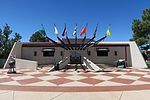Los Ranchos de Albuquerque, New Mexico
Albuquerque metropolitan areaUse mdy dates from July 2023Villages in Bernalillo County, New MexicoVillages in New Mexico

Los Ranchos de Albuquerque, known locally simply as "Los Ranchos" or "The Village," is a village in Bernalillo County, New Mexico. The population was 6,024 at the time of the 2010 Census.
Excerpt from the Wikipedia article Los Ranchos de Albuquerque, New Mexico (License: CC BY-SA 3.0, Authors, Images).Los Ranchos de Albuquerque, New Mexico
Los Prados de Guadalupe Northwest,
Geographical coordinates (GPS) Address Nearby Places Show on map
Geographical coordinates (GPS)
| Latitude | Longitude |
|---|---|
| N 35.161666666667 ° | E -106.64638888889 ° |
Address
Los Prados de Guadalupe Northwest 857
87107
New Mexico, United States
Open on Google Maps







